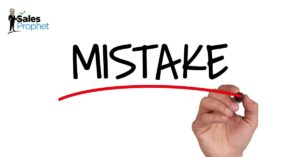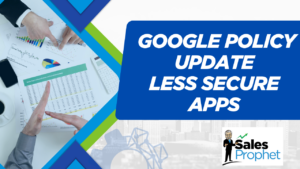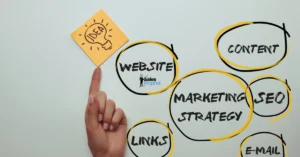Account-based email is easy to launch and non-disruptive to your current sales & marketing processes.
Sales Lead Automation, the parent company to Sales Prophet, has sent millions of B2B marketing and sales emails using mass email, sales automation email and now account based emails. We can say with 100% certainty that account-based email is one of our top performing tactics. (When done correctly).
We should also mention that we don’t believe you can fully automate an account based email program, nor should you. These are your top prospects and they need to be handled slightly differently than say a typical sales automation program. We should also mention that we have automated several aspects of these campaigns but they still require some manual management to be most effective.
We will get into the process of sending account-based emails later in this blog post.
Account-Based Marketing (ABM)
ABM has been the rage of marketers for a few years now, but at first, I was skeptical.
Why?
There are a lot of moving parts to launching an account-based marketing program and it often requires unique content, new processes, and new technologies. Not to mention, every client I have worked with over the past 15 years has told me they want to launch an account-based marketing program, but don’t know where to start.
We believe account based email is where you should start and the reason is simple.
Account based email is easy to launch and non-disruptive to your current sales and marketing processes. It also gets you started down the road of account-based marketing with the basics intact.
Getting Started with account-based email
If you ask most salespeople to identify their top target accounts they want to go after, 9 times out of 10 they will tell you they want to go after the biggest companies. (The whales of your industry).
And they would be wrong.
When it comes to account-based email or marketing for that matter, you want to focus on the most profitable companies with the highest lifetime value (LTV). This might require some feedback from your finance department as to the most profitable clients as well as your Operations team to find the easiest clients to work with because these clients generally remain customers for longer periods of time which equates to more revenue.
Its always more profitable to keep an existing customer than to find a new one.
Once you have your list of ideal customers, try to find out why they are good customers.
How did they become customers?
What put them into an active buying process?
Was it new regulations or technology that impacted their industry?
Was is new leadership or preexisting relationship?
Was it an operational issue like poor production, quality, or volume?
Did they outgrow their existing vendor?
Was there a new initiative that put them into an active buying process?
Did they receive new funding?
You might have to reach out to these customers and ask them these questions which is never a bad thing to do.
Based on your findings, build out an ideal customer profile.
We get into how to build out a complete ideal customer profile here if you need help.
Who is involved in the buying process?
Keep in mind that there are usually several people involved in the buying process at these target accounts.
Gartner’s research recently reported there are usually six to ten decision-makers in any major purchase decision.
In most cases, you will have people from various departments, job titles, job levels, all with unique responsibilities, needs, and challenges. Your goal is to engage each and every one of these decisionmakers and make yourself as relevant as possible.
Sales Time is limited
A typical salesperson only gets about 5-6% of a buyer’s time when making a purchase decision.
That’s not a lot of time to build a relationship with each person that is part of the buying committee, let alone collect the necessary information needed to provide the best possible solution to their problem or concern.
Start by reviewing your past successes from your best customers and build a list of all the critical personas involved in that buying process.
At a minimum, there is usually an influencer, decision-maker, end-user, financial authority and a blocker involved in all major purchase decisions.
Example:
Let’s say you provide employee relocation/moving services to companies with at least 200 employees.
For your account-based email efforts, you might want to target larger more profitable companies, i.e., companies with more than 5000 employees and growing at a specific rate or in specific industries that are located in states where you have a strong local presence.
Ideally you would target companies showing interest or intent in corporate relocation services, or hiring for a relocation manager, or companies who received additional funding for a new initiative or perhaps companies who match your ICP who have announced they are moving headquarters.
Regardless of how you came up with your top target accounts, the next step is finding the right contacts at those companies.
We like to identify and target contacts with certain keywords in their job title, like Chief Human Resource Officer, since we know they will play a role in selecting a moving partner.
Don’t forget to include acronyms, i.e. (CHRO) and variations of those job titles like Chief People Officer or Chief Happiness Officer.
You will also want to include other human resource or HR titles possibly involved in the buying process. For this example, you might want to include anyone that is a Manager and above with these keywords in their job title: HR, Human Resources, Relocation, Mobility, Compensation, Talent, Recruiter, Recruiting, Benefits and Total Rewards.
You can tell a lot about a company if they have a dedicated person responsible for corporate mobility and/or employee relocations. That’s a good indication that the company moves a lot of people and should be included in your account based email program.
For the financial persona, you will want to include contacts who have these keywords in their job title: procurement, purchasing, finance, chief financial officer, (CFO) business analyst etc.
If your product or services involves Operations, then you will also want to add the keyword “operations” or “COO” to your contact search.
Now What?
Once you have identified your target accounts and comprised a list of all contacts with ideal job titles, it’s time to find or buy all of the relevant/matching contacts.
Most companies must go to a third-party data provider to buy this contact data, which can get very expensive. Since we already own over 85 million contact records, our clients don’t have to buy the data, they simply use our data. (It’s part of our software as a service)
The reality is you don’t want to buy millions of contact records. It’s too expensive and often junks up your CRM with unused data that degrades anywhere from .05 to 1% a week. So if you buy 500,000 contact records in a years’ time that list will only have around 250,000 valid contact records 12 months later. B2B Data is a degrading asset.
Plus, most CRM providers charge by the number of contacts you have in their system. So, it’s much better to use our data and import just the contacts who have expressed interest in your products and services vs. a bunch of contacts you don’t know if they will have any interest at all.
B2B Email Verification
Once we have identified our ideal accounts, we begin the email verification process. This is a very important process that helps ensure we maintain a good email reputation and deliverability.
We have integrated Sales Prophet with emailoversight so you don’t have to download the data, upload into a email verification service like emailoversight and then re-upload the data back into Sales Prophet to add to a campaign. Simply click on verify the list and a few minutes later, you new list is created with the verification results.
Who do you contact at these target accounts?
After you have verified all of your relevant contacts and you have verified all of contact data, the next step is to determine who is the most senior person or decision maker typically involved in buying process.
EXAMPLE:
Let’s say you offer logistic and shipping solutions to companies with more than 500 employees in certain industries. You might want to prioritize the Vice President of Global Logistics and tag that contact as Influencer 1 while Supply Chain Supervisor might be tagged as Influencer 2 and Procurement Director might get tagged as Influencer 3.
So you would send the email to the most senior person in this case the VP of Global Logistics and copy the other two influencers.

These Account based emails are getting a 67% open rate and over 20% reply to rates (On average) which is huge compared to other sales automated emails or mass email campaigns.
Why are Account-based emails so effective?
By copying three people into the same email, two things happen. First the prospect sees you have done your homework by copying 3 key influencers’ at the company. Second by copying three people, chances are someone will be compelled to respond, especially when you message someone’s boss.
Typical responses we see include:

The Challenges
Normally these emails are created manually and its takes 8 cut and pastes from an excel document to your email to complete. This of course takes time and commitment to send 50 or so emails a day.
That’s why we built Sales Prophet to help pick and choose the right contacts at your target accounts and add them to your account-based email campaigns. Sales Prophet speeds up this process a 1000 times.
SUMMARY
If you don’t have the money or resources to launch a complete Account-based marketing program or you’re not happy with your account-based marketing efforts, consider this account-based email approach.
1. Pull a list of Ideal companies and contacts.
2. Sort your list by company and manually flag 3-6 influencers’ at each of your target companies.
3. Hire a virtual assistant or plan to send these one-off emails yourself by copying each of the
influencers into the same email.
The results will be fantastic!




